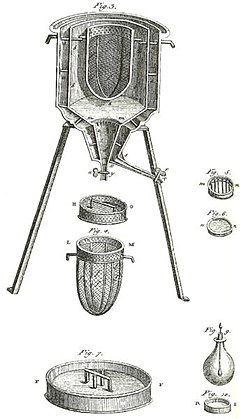Thermochemistry
Thermochemistry is the study of energy and heat that are converted into chemical reactions. Energy can be released or absorbed during a reaction or phase transition . Thermochemistry focuses on the quantification of the energy exchange, mostly on the exchange between the system and the environment . Thermochemistry is used to predict the quantities of reactants and products in a reaction. In combination with entropy determination, it can also be used to predict whether a reaction will take place spontaneously or not.
Endothermic reactions absorb heat from the environment, while exothermic reactions release heat. Thermochemistry combines the concepts of thermodynamics with the concept of energy in the form of chemical bonds. The topic usually includes calculations of quantities such as heat capacity , enthalpy of reaction , entropy , free enthalpy and energy.
history

Thermochemistry is based on two model assumptions. In a modern formulation this can be expressed as follows:
- The postulate of Lavoisier and Laplace (1780): The amount of energy converted in any conversion is equal to the negative amount of energy in the opposite conversion.
- The theorem of Hess (1840): The enthalpy change of a reaction depends only on the initial and final state, not on the way in which they were reached.
These assumptions were the forerunners of the first law of thermodynamics (1845) and made possible its formulation.
Lavoisier, Laplace and Hess were also involved in the definition of specific heat capacity and latent heat , although Joseph Black ultimately made the final contributions to the development of the concept of latent heat transport.
Gustav Kirchhoff showed in 1858 that the change in the enthalpy of reaction is given by the change in the heat capacity of reactants to products:
- .
The integration of this equation allows the evaluation of the enthalpy of reaction at one temperature from the measurement results at another temperature.
Calorimetry
The determination of enthalpy changes is carried out by means of calorimetry , usually in a closed container in which the process to be observed takes place. The temperature of the container is monitored either by a thermometer or a thermocouple and plotted against time. Modern calorimeters are usually equipped with digital sensors and software to make results available for evaluation quickly. An example of this is dynamic differential calorimetry ( differential scanning calorimetry , or DSC for short ).
Systems
Various thermodynamic definitions can be very helpful in thermochemistry. A system is defined as exactly that part of the universe that is to be analyzed. Everything outside the system is defined as an environment . Examples of a system are:
- a (completely) isolated system , which can neither exchange energy nor matter with the environment, in a first approximation a bomb calorimeter
- a thermally insulated system that can exchange neither heat nor matter, but mechanical work, for example a piston or a balloon
- a mechanically isolated system that can exchange neither mechanical work nor matter, but heat, for example an open bomb calorimeter
- an open system that can freely exchange both matter and energy with the environment, for example a pot of boiling water
Processes
A system is subject to a process when one or more of its thermodynamic properties change. A process always relates to the change in a state . An isothermal process occurs when the temperature of the system remains the same. An isobaric process occurs when the pressure of the system remains constant. One speaks of an adiabatic process when there is no heat exchange with the environment.
Individual evidence
- ^ Pierre Perrot: A to Z of thermodynamics . Oxford University Press, Oxford; New York 1998, ISBN 0-19-856556-9 .
- ^ Frederick Hutton Getman: Outlines of Theoretical Chemistry . John Wiley & sons, New York 1918, p. 290 ( limited preview in Google Book Search).
- ^ Peter W. Atkins, Julio De Paula: Physical chemistry . 5th edition. Wiley-VCH, Weinheim 2013, ISBN 978-3-527-33247-2 , pp. 75 .
